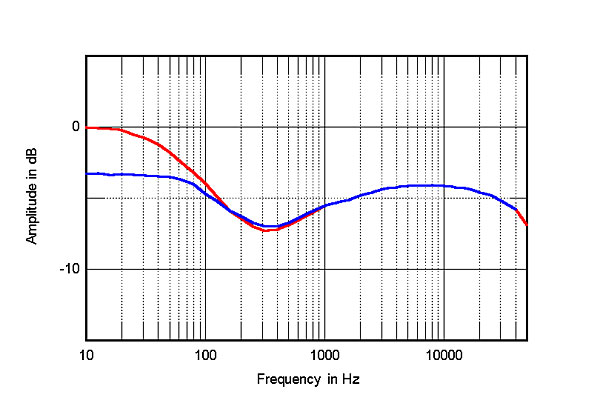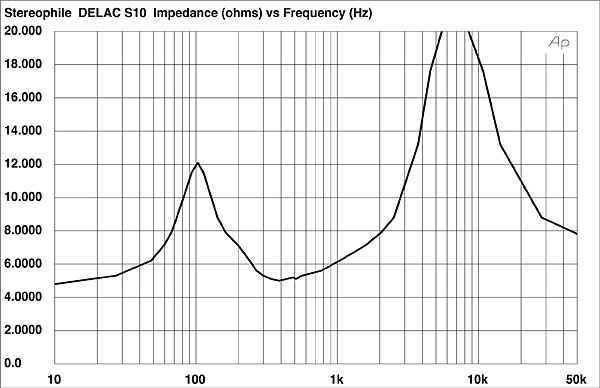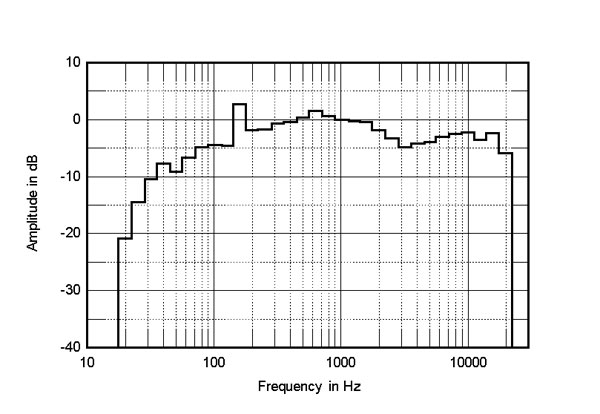| Columns Retired Columns & Blogs |
with similar colorations and similar stellar imaging attributes. I loved my TC-50s and regretted selling them. What they did well, they did REALLY well.
The higher-than-usual source and load impedances presented by the Mod Squad Line Drive and VTL 100W power amplifier (more than 2000 ohms including source, and 130k ohms, respectively) mandated my using the "H" version of the E10. I assessed its effect on the signal by measuring the voltage at the VTL's output terminals while the amps were connected to the speakers. (It will therefore include the interaction between the power amp's 1 ohm output impedance and the impedance curve of the speaker. I thought this valid as it actually will relate to what I heard.)
The "50Hz" setting gave a level approximately 3.5dB lower than the "80Hz": fig.2 shows the response for both ("50" red, "80" blue, with the latter reduced by 3.5dB to make the difference between them more clear). Set to "50Hz," the maximum effective boost in my system was 5.5dB at 20Hz compared with the level at 1kHz, though a dip of nearly 2dB also appeared in the lower mids. At first I suspected that this was due to the interaction between the speakers and the VTLs, but as it was also apparent, if less severe, on the response curve taken with the "L" version of the E10 connected between signal generator and millivoltmeter, I assume it is intentional. The rise of 1.5dB in the treble compared with the midrange however, is, I am sure, an artifact of the power amplifier's highish output impedance. Set to "80Hz," the E10 applies a modest 3dB of boost in the bass with respect to the level at 1kHz.

Moving on to the manner in which the S10's impedance changes with frequency (fig.3), the fundamental box resonance can be seen to be well-damped, lying at a high 103Hz. The specification suggests a minimum of 3.5 ohms, but I measured a little higher than that, the load dropping to just below 5 ohms in the lower midrange. Current-miserly receivers, or tube amplifiers without a 4 ohm tap, should be avoided, nevertheless. The voltage sensitivity for the 1kHz 1/3-octave band appeared to be around 87dB/W/m, though the low impedance means this will be around 2–3dB too high (the 2.83V is equivalent to more than 1W). I would suggest that modestly powered amplifiers delivering less than 50W into 8 ohms would be best avoided with the DELACs.

The frequency response in the listening area was measured using pink noise and an Audio Control Industrial SA-3050A 1/3-octave spectrum analyzer. Nine sets of six averaged measurements were taken independently for left and right loudspeakers at a distance of just over 2m in a window 72" wide and varying from 27" to 45" high. The response shown in each review is the average of these measurements, weighted slightly toward the sound heard at the listening position. This spatial averaging is intended to minimize the effect of low-frequency room standing-wave problems on the measurement, and gives a response curve that has proved to correlate reasonably well with what is perceived; it also gives an idea of the off-axis behavior of the speaker under test. The spatially averaged in-room response of the S10s, taken with the passive equalizer set for maximum bass extension, is shown in fig.4.

Low frequencies can be seen to be lightweight, something confirmed by the nearfield measurements, assessed with a sinewave sweep to get an idea of the true bass extension relative to the level at 100Hz, which indicated a –6dB point at 62Hz referred to the level at 200Hz ("50Hz") and at 80Hz ("80Hz"). Without the E10 in circuit, the response was –6dB at 100Hz, suggesting that the S10s would be best used with a subwoofer if any significant levels of bass are required. The gently rolled-off nature of the low frequencies is typical of an overdamped alignment. It might be thought that more bass boost/midrange cut would be the answer to the lack of bass weight, but I suspect that this would render the insertion loss of the passive E10 equalizer too great for practical purposes.
There appears to be a slight lack of energy in the crossover region, which, in conjunction with the overdamped bass, gives a midrange prominence to the response. To some extent, this is due to the wide lateral dispersion in the mids engendered by the use of such a narrow enclosure. A quasi-anechoic measurement taken outside revealed rather less energy between 500Hz and 800Hz, but the curve still had the same basic shape. Certainly it correlates strongly with the mid-forward tonal balance noted in the listening tests.
The best integration of the sounds from the drive-units was on the axis between the tweeter and front woofer. Above that, and a severe notch developed in the region between 2500Hz and 6300Hz. A listener would have to be standing, however, to be on this axis.
As expected, the small cabinet was quite rigid, being effectively dead over much of the midband, though some mild resonant behavior was noted at 180Hz and 240Hz.
One final aspect of the S10 remains unconfirmed. In their promotional literature, Delaware Acoustics show an excellent 1kHz squarewave, said to have been produced by the S10 (though the measuring axis is not mentioned), which implies excellent time-domain behavior for the speaker. Try as I could, I could not find a mike position where it was possible to duplicate this squarewave performance. It might be that I just didn't search hard enough, however.—John Atkinson

with similar colorations and similar stellar imaging attributes. I loved my TC-50s and regretted selling them. What they did well, they did REALLY well.